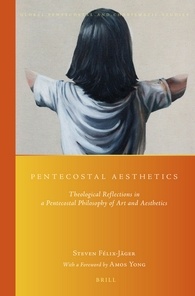Steven Felix-Jager: Pentecostal Aesthetics
 Steven Félix-Jäger, Pentecostal Aesthetics: Theological Reflections in a Pentecostal Philosophy of Art and Aesthetics, Global Pentecostal and Charismatic Studies 16 (Leiden: Brill, 2015) ISBN 9789004285637.
Steven Félix-Jäger, Pentecostal Aesthetics: Theological Reflections in a Pentecostal Philosophy of Art and Aesthetics, Global Pentecostal and Charismatic Studies 16 (Leiden: Brill, 2015) ISBN 9789004285637.
Hardly a Christian tradition is more obsessed with the physical and embodied forms of the Christian life than Pentecostalism. The Pentecostal movement manifests a change among contemporary religious traditions in major part because of its emphasis on the holistic nature of human participation in the experience of God. All the more surprising is therefore that Pentecostals have not sufficiently developed a distinctively Pentecostal philosophy of art and aesthetics. In Pentecostal Aesthetics, with a foreword by Amos Yong, Steven Félix-Jäger addresses this lacuna by reflecting theologically on art and aesthetics from a global Pentecostal perspective and through a pneumatological lens. He contends that Pentecostal aesthetics emerges from the global, experiential, and Spirit-centered nature of the Pentecostal movement. The book proposes that Pentecostal aesthetics can be ontologically grounded in a relativistic theory of art that is sensitive to its ontological foundations. The surprising outcome of this endeavor is that from today’s contemporary artworld Pentecostals can gain abundant insight about the work of the Holy Spirit.
Hardly a Christian tradition is more obsessed with the physical and embodied forms of the Christian life than Pentecostalism.
The first part of the book details in two chapters the broader history of art and the ontological grounds for a Pentecostal philosophy of art and aesthetics. The first chapter follows historical trends in art and aesthetics and traces the cultural conditions in the West. The second chapter seeks to ground aesthetics within an appropriate philosophical system for identifying Pentecostal contributions. Félix-Jäger argues that a Pentecostal philosophy of art and aesthetics is grounded in the pneumatocentric and experiential aspects of Pentecostal spirituality.
What is the nature of beauty?
Category: In Depth, Winter 2016


